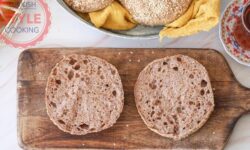Discover Delicious Gluten-Free Foods: Your Ultimate Guide to Healthy Eating!
Eating healthy has never been more important, especially as we become increasingly aware of how certain foods impact our health. For those with gluten sensitivities or celiac disease, the question often arises: what are gluten-free foods? This ultimate guide aims to provide you with essential information on why a gluten-free diet could be beneficial for you, along with delicious recipes and tips for navigating your gluten-free journey. Join us as we explore a variety of scrumptious alternatives that promise a healthy and satisfying eating experience.
Understanding Gluten and Its Impact on Health
Gluten is a protein found primarily in wheat, barley, and rye. For many, gluten poses no health issues; however, for others, particularly those with celiac disease or gluten sensitivity, gluten can result in serious health complications. Here’s how gluten impacts health:
- Celiac Disease: A severe autoimmune disorder where ingestion of gluten leads to damage in the small intestine. Symptoms include bloating, diarrhea, and significant long-term health issues.
- Non-Celiac Gluten Sensitivity: Individuals may experience symptoms similar to celiac disease without the intestinal damage. Common reactions include fatigue, headaches, and joint pain.
- Wheat Allergy: Unlike celiac disease, a wheat allergy triggers an immune response to proteins in wheat, including but not limited to gluten.
Symptoms and Side Effects
When discussing What are Gluten-Free Foods?, it’s crucial to understand these potential symptoms:
| Symptom | Celiac Disease | Non-Celiac Gluten Sensitivity | Wheat Allergy |
|---|---|---|---|
| Digestive Issues | Yes | Yes | Yes |
| Fatigue | Yes | Yes | No |
| Weight Loss | Yes | No | No |
| Skin Rashes | Yes | Rarely | Yes |
| Joint Pain | Rarely | Yes | No |
For those affected, adopting a gluten-free diet is crucial to maintain health and promote overall well-being. Knowing What are Gluten-Free Foods? not only empowers individuals to make better dietary choices but also fosters a healthier lifestyle.
The Benefits of a Gluten-Free Diet
Embracing a gluten-free diet offers numerous advantages that can significantly improve your overall health and well-being. By strategically avoiding gluten—a protein found in wheat, barley, and rye—you can experience positive outcomes, especially if you’re sensitive to gluten. Here are some primary benefits to consider:
Enhanced Digestive Health: Many people report relief from symptoms such as bloating, gas, and diarrhea when they eliminate gluten. For those with celiac disease or non-celiac gluten sensitivity, avoiding gluten is crucial for maintaining a healthy digestive system.
Increased Energy Levels: By consuming gluten-free foods, individuals often experience a boost in energy as their bodies can absorb nutrients more efficiently without the interference of gluten.
Weight Management: A gluten-free diet may lead to healthier food choices, as people often switch to wholesome alternatives like fruits, vegetables, and gluten-free grains. These options can support weight loss or maintenance.
Improved Mood: Some studies suggest that cutting out gluten can enhance mood and mental clarity, particularly for individuals with gluten-related disorders.
Reduced Inflammation: A gluten-free approach can help in lowering inflammation for those who are sensitive, potentially alleviating associated conditions, such as joint pain.
In summary, adopting a gluten-free lifestyle can lead to improved digestive health, increased energy, better weight management, enhanced mood, and reduced inflammation. When people ask, “What are Gluten-Free Foods?” it’s essential to emphasize how they can contribute to these health benefits.
Key Ingredients for Gluten-Free Cooking
When transitioning to a gluten-free lifestyle, it’s essential to understand key ingredients that can elevate your meals. So, what are gluten-free foods? They are ingredients that do not contain gluten, a protein found in wheat, barley, and rye. Here’s a breakdown of some vital gluten-free components suitable for various recipes:
Essential Gluten-Free Ingredients:
Gluten-Free Grains:
- Rice: A versatile and easy-to-cook staple.
- Quinoa: Packed with protein and nutrients, it’s perfect for salads or bowls.
- Corn: Use cornmeal for baking or polenta as a base for dishes.
Flours:
- Almond Flour: Ideal for baking, it offers a nutty flavor.
- Coconut Flour: Best for thickening and adds a subtle sweetness.
- Chickpea Flour: Great for savory recipes, providing a unique texture.
Binders:
- Eggs: They act as a natural binder in many dishes, enhancing moisture and flavor.
- Applesauce: A gluten-free alternative for moisture in baking.
- Xanthan Gum: Helps replicate the elasticity of gluten in baking.
Comparison Table: Gluten-Free vs. Traditional Ingredients
| Ingredient Type | Gluten-Free Options | Traditional Options |
|---|---|---|
| Grains | Quinoa, Rice | Wheat, Barley |
| Flours | Almond, Coconut | All-Purpose, Wheat |
| Binders | Eggs, Applesauce | None required (in many recipes) |
In conclusion, understanding what are gluten-free foods and incorporating them thoughtfully into your cooking can yield delicious and satisfying meals. Embrace these ingredients to enjoy a diverse and flavor-packed menu!
Delicious Gluten-Free Breakfast Ideas
Starting your day with a nutritious breakfast is crucial, especially if you’re adhering to a gluten-free diet. So, what are gluten-free foods you can enjoy in the morning? Here’s a selection of mouthwatering options that cater to your breakfast cravings while keeping you free from gluten.
Top Gluten-Free Breakfast Ideas:
Smoothie Bowls: Blend your favorite fruits with yogurt or non-dairy alternatives, and top with gluten-free granola or seeds for an extra crunch.
Omelets: Egg-based dishes are inherently gluten-free. Fill them with vegetables, cheese, or meats for a protein-packed meal.
Quinoa Porridge: Cook quinoa with almond milk, and add toppings like berries, nuts, and honey. It’s a hearty and gluten-free alternative to oatmeal.
Chia Seed Pudding: Mix chia seeds with coconut milk and sweeten with vanilla or agave. After refrigerating overnight, you’ll have a nutritious breakfast ready to go.
Buckwheat Pancakes: Despite its name, buckwheat is gluten-free. Prepare delicious pancakes using buckwheat flour for a gluten-free twist.
Quick Comparison of Breakfast Options
| Breakfast Idea | Preparation Time | Gluten-Free? |
|---|---|---|
| Smoothie Bowls | 5 minutes | ✔️ |
| Omelets | 10 minutes | ✔️ |
| Quinoa Porridge | 15 minutes | ✔️ |
| Chia Seed Pudding | 5 minutes (plus overnight) | ✔️ |
| Buckwheat Pancakes | 20 minutes | ✔️ |
In summary, knowing what are gluten-free foods can help you whip up delightful breakfast options without compromising on flavor or nutrition. Enjoy experimentation with these tasty recipes to kickstart your day!
Wholesome Gluten-Free Snacks to Try
Finding satisfying and tasty snacks that adhere to your dietary preferences can be a delightful experience. So, what are gluten-free foods? Essentially, they are products that do not contain wheat, barley, or rye. Here, we will explore some wholesome gluten-free snacks you should definitely try:
Fresh Fruits and Vegetables: Nature’s snacks! Fruits like apples, berries, or grapes and crunchy veggies like carrots or bell peppers provide essential vitamins and fiber.
Nuts and Seeds: A great source of healthy fats, protein, and fiber. Options such as almonds, walnuts, chia seeds, or pumpkin seeds can give you an energy boost.
Rice Cakes: Light and versatile, rice cakes can serve as a fantastic base for various toppings, from avocado to nut butter.
Popcorn: A satisfying whole-grain snack when prepared without butter. Opt for air-popped varieties to keep it healthy!
Gluten-Free Granola Bars: Look for bars made with gluten-free oats and minimal additives. These can be a great on-the-go option.
Comparison Table of Popular Gluten-Free Snacks
| Snack Type | Nutritional Benefits | Ease of Preparation |
|---|---|---|
| Fresh Fruits & Veggies | High in vitamins, low in calories | Ready to eat |
| Nuts & Seeds | Rich in protein & healthy fats | No preparation needed |
| Rice Cakes | Versatile and light | Quick to prepare |
| Popcorn | Low-calorie whole grain | Easy to make |
| Granola Bars | Convenient, often packed with fiber | Store-bought or homemade |
By incorporating these wholesome gluten-free snacks, you not only enjoy delicious flavors but also support your health. So next time you’re pondering what are gluten-free foods?, remember that healthy snacking can be both enjoyable and beneficial!
Nutritious Gluten-Free Lunch and Dinner Options
When exploring what are gluten-free foods, it’s essential to recognize that there are numerous nutritious options available for lunch and dinner. These meals can be both satisfying and health-conscious, ensuring you maintain a balanced diet without gluten. Below are some delicious gluten-free ideas to inspire your meals:
Lunch Ideas:
- Quinoa Salad: Combine cooked quinoa with fresh vegetables, bean sprouts, and a light vinaigrette for a protein-packed salad.
- Chickpea Salad Sandwich: Mash chickpeas and mix with avocado, diced veggies, and seasonings, then serve on gluten-free bread.
- Zucchini Noodles: Use a spiralizer to create zucchini noodles, topped with marinara sauce and grilled chicken or shrimp.
Dinner Ideas:
- Stuffed Bell Peppers: Fill bell peppers with a mixture of brown rice, ground turkey, and spices, then bake until tender.
- Baked Salmon and Asparagus: Season salmon with herbs and lemon, roast it alongside asparagus for a fulfilling meal.
- Cauliflower Rice Stir-Fry: Sauté cauliflower rice with mixed vegetables, tofu, or chicken, and soy sauce for a low-carb dinner option.
Comparison of Gluten-Free Grains:
| Grain | Gluten-Free | Nutritional Benefits |
|---|---|---|
| Quinoa | Yes | High in protein and fiber |
| Brown Rice | Yes | Source of magnesium and B vitamins |
| Buckwheat | Yes | Rich in antioxidants |
In summary, understanding what are gluten-free foods can open doors to a world of nutritious lunch and dinner options. Whether you’re preparing a quick meal or a family dinner, options abound that will keep you on track with your gluten-free lifestyle.
Tips for Dining Out on a Gluten-Free Diet
Dining out while adhering to a gluten-free diet can be challenging, but it doesn’t have to be overwhelming. Here are some effective tips to help you navigate restaurant menus with confidence and enjoy your meal:
Research Ahead: Before you head out, check the restaurant’s website for their menu. Many establishments now highlight gluten-free options.
Call Ahead: Don’t hesitate to call the restaurant in advance. Ask about their gluten-free offerings and their protocols for preventing cross-contamination.
Communicate Clearly: When ordering, inform your server about your gluten-free needs. Use phrases like, “I need a gluten-free meal due to health reasons.”
Cross-Contamination Awareness: Be cautious with food preparation areas. Avoid dishes cooked alongside gluten-containing items. Opt for grilled or baked selections rather than fried.
Stick to Simple Foods: Choose meals that are naturally gluten-free, such as salads, grilled meats, or seafood, and request dressings or sauces on the side.
Desserts and Drinks: Gluten-free desserts might be limited, but many places offer fruit or sorbet. Moreover, ensure beverages are gluten-free by checking beer and cocktail mixers.
By following these tips, you can confidently enjoy dining out. Remember, knowing what are gluten-free foods is key to making informed dining choices. Embrace the adventure of trying new places while staying true to your dietary needs!
How to Read Labels for Gluten-Free Products
Understanding how to read labels for gluten-free products is essential for anyone transitioning to a gluten-free diet. This knowledge helps ensure you choose safe foods effectively. Here are some key points to consider:
Look for Certified Gluten-Free Label: Products labeled with a gluten-free certification typically meet stringent standards (less than 20 parts per million of gluten).
Ingredients List: Always check the ingredients list carefully. Common gluten-containing ingredients include:
- Wheat
- Barley
- Rye
- Triticale
Cross-Contamination Warnings: Watch for statements like “may contain wheat” or “processed in a facility that also processes wheat.” These can indicate a risk of gluten exposure.
Whole-Grain Options: While many whole grains are gluten-free (like quinoa and brown rice), ensure they are clearly labeled as gluten-free to avoid any potential mix-ups.
Comparison Table of Gluten-Containing and Gluten-Free Products
| Category | Gluten-Containing Products | Gluten-Free Alternatives |
|---|---|---|
| Grains | Wheat flour, barley | Rice flour, almond flour |
| Breads | Traditional bread | Gluten-free bread |
| Snacks | Crackers, cookies | Rice cakes, gluten-free cookies |
By practicing these label-reading tips, you will have a better understanding of what are gluten-free foods? This knowledge empowers you to make informed and delicious choices in your gluten-free journey.
Incorporating Gluten-Free Foods into Your Lifestyle
Adopting a gluten-free lifestyle can significantly enhance your health, but it requires a mindful approach to your eating habits. To seamlessly integrate gluten-free foods into your daily routine, consider the following strategies:
Meal Planning: Design your weekly meals with gluten-free options in mind. Focus on whole foods like fruits, vegetables, lean proteins, and gluten-free grains such as quinoa, rice, and buckwheat.
Grocery Shopping: Familiarize yourself with gluten-free products and brands. Always look for labels that clearly state “gluten-free.” Here’s a quick comparison of common gluten-containing foods versus gluten-free alternatives:
| Gluten-Containing Foods | Gluten-Free Alternatives |
|---|---|
| Wheat Bread | Gluten-Free Bread |
| Pasta | Rice or Quinoa Pasta |
| Barley | Certified Gluten-Free Oats |
| Beer | Gluten-Free Beer |
Snack Options: Keep gluten-free snacks handy for busy days. Nuts, dried fruits, popcorn, and gluten-free granola bars make excellent choices.
Educate Yourself: Understanding what are gluten-free foods allows you to make informed decisions. Read ingredient labels carefully to avoid hidden gluten in processed foods.
Culinary Creativity: Explore new gluten-free recipes. Substitute gluten-containing ingredients with gluten-free options, enhancing your cooking skills while enjoying delicious meals.
By implementing these strategies, you’ll not only embrace a gluten-free lifestyle but also discover a variety of nutritious and scrumptious gluten-free foods that cater to your dietary needs.
Frequently Asked Questions
What types of gluten-free foods can I include in my diet?
There is a wide variety of delicious gluten-free foods available that can become staples in your diet. These include whole fruits, vegetables, legumes, nuts, seeds, and gluten-free grains such as quinoa, rice, and corn. Additionally, many dairy products, meats, and fish are naturally gluten-free. When shopping, look for packaged foods labeled as ‘gluten-free’ to ensure safety and avoid cross-contamination.
How can I ensure that my meals are balanced while following a gluten-free diet?
To maintain a balanced diet while following a gluten-free regimen, it’s essential to include a variety of food groups in your meals. Focus on incorporating plenty of vegetables and fruits for essential vitamins and minerals. Pair them with healthy proteins such as poultry, fish, tofu, or legumes, and choose whole gluten-free grains for carbohydrates. Incorporating healthy fats from sources like avocados and nuts can also contribute to a balanced intake.
Are there any risks associated with a gluten-free diet?
While a gluten-free diet can be beneficial for those with celiac disease or non-celiac gluten sensitivity, it may carry risks for others if not well-planned. One of the main concerns is nutritional deficiencies, as gluten-free foods may lack essential nutrients, including fiber, iron, and certain B vitamins. Moreover, some gluten-free packaged products can be high in sugar and fat. Consulting with a healthcare professional or a registered dietitian can help mitigate these risks.
What are some common gluten-free snacks?
There are many healthy and satisfying gluten-free snacks to choose from. Popular options include popcorn, rice cakes, hummus with vegetables, fruit, and yogurt. Additionally, gluten-free granola bars and trail mix can offer a convenient snack on the go. Always check labels to ensure snacks are certified gluten-free, and consider making homemade snacks to better control ingredients.
How can I dine out safely on a gluten-free diet?
Dining out while adhering to a gluten-free diet requires careful planning and communication. It is prudent to research restaurants that offer gluten-free options and read reviews from fellow diners. When at the restaurant, inform your server about your dietary needs, and ask about their procedures to prevent cross-contamination. Many establishments are accommodating, but it’s crucial to ensure that dishes are prepared in a gluten-free environment.



